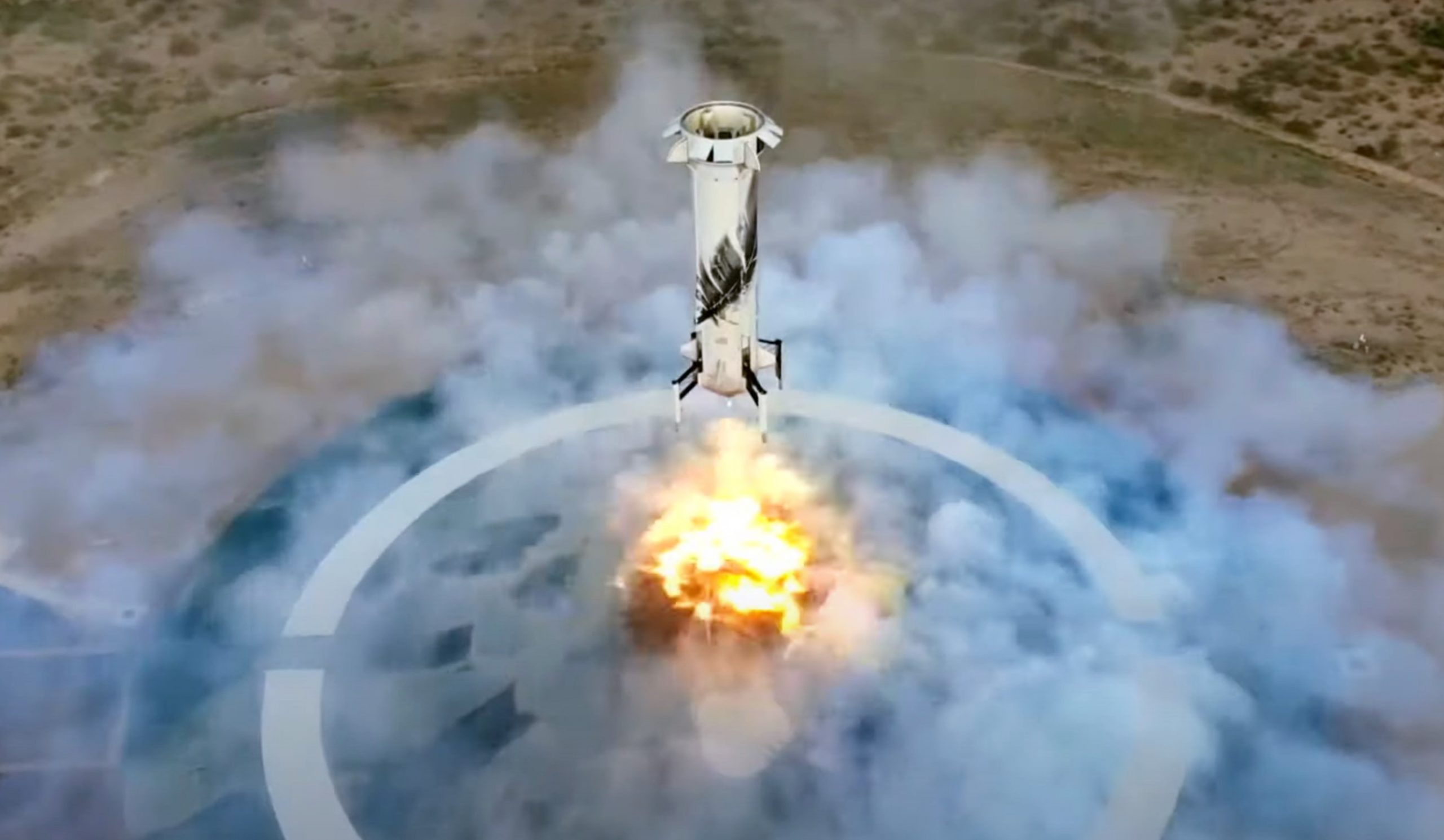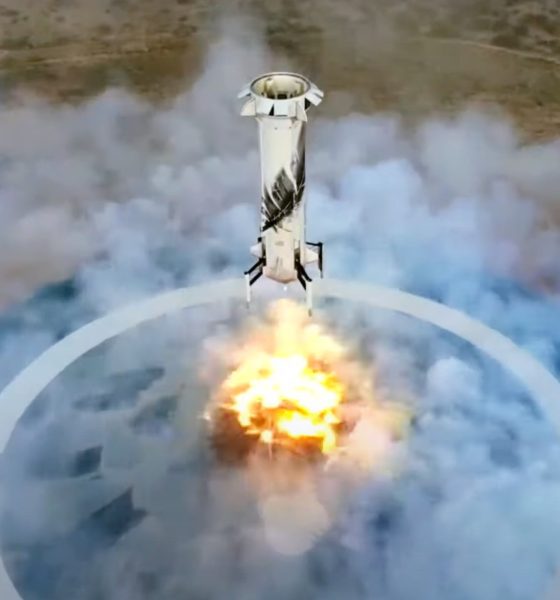

News
Blue Origin launches first suborbital tourists after six years and 15 test flights
More than six years after New Shepard’s first test flight and nine years after a pad abort featuring a prototype of the rocket’s capsule, Blue Origin has launched its first crew of suborbital tourists.
Almost exclusively funded by Amazon CEO Jeff Bezos’ stock sales over more than 21 years of operations, Blue Origin has been working towards New Shepard’s first crewed launch for approximately a decade. Aside from a pad abort test of the rocket’s relatively simple ‘crew capsule’ in October 2012, New Shepard – purported to be fully reusable – has performed 15 uncrewed test flights since April 2015. At least according to Blue Origin, of those 15 tests, 14 were fully successful and 11 crossed the 100 km (~62 mi) Karman Line – a largely arbitrary line drawn between Earth’s atmosphere and space.
Six years and three months after New Shepard’s first flight, the rocket lifted off on its 16th suborbital mission and inaugural crewed launch. Along for the ride were Jeff Bezos himself, brother Mark Bezos, hedgefund multimillionaire Joes Daemen’s son Oliver Daemen, and trailblazing pilot and aviator Mary “Wally” Funk.
While New Shepard NS-16 reached an apogee of 107 km (66 mi) and a maximum speed of 2233 mph (1 km/s / Mach 2.9), less than 13% of the way to orbit, the mission did mark a number of “spaceflight” firsts insofar as its passengers did technically spend between 70 and 150 seconds in “space.” Notably, NS-16 passengers Oliver Daemon and Wally Funk are now respectively the youngest and oldest people in history to reach space. While Blue Origin hasn’t disclosed the value of his second-place bid, Oliver Daemen was technically a paying customer, making New Shepard the first rocket in history to launch a paying passenger on its first crewed flight.
In June, Blue Origin held a tone-deaf auction that ultimately resulted in a mystery buyer winning the first ticket on New Shepard at a jaw-dropping cost of $28 million – just shy of the $30M Richard Garriott paid to ride a Soyuz rocket to space, spend almost two weeks in orbit, and scream back to Earth at Mach 25. Bizarrely, the company still hasn’t revealed the winner, at no point mentioned that there would be runners-up, inexplicably swapped the mystery winner for Oliver Daemen with “scheduling issues” as the comical excuse, and has yet to reveal what Daemen paid for his ticket. In general, Blue Origin still refuses to provide any information about the price of seats on New Shepard.
Meanwhile, although Blue Origin did provide invite-only access to some media outlets and offered numerous interview opportunities with the NS-16 crew, there have been virtually zero chances for reporters and journalists to ask real questions. Beyond New Shepard, which raises dozens of questions on its own, Blue Origin’s orbital New Glenn rocket is years behind schedule and apparent issues with the BE-4 engine meant to power both it and the United Launch Alliance’s (ULA) Vulcan has also significantly delayed the latter rocket’s launch debut.
For the last several years, Vulcan and New Glenn were both aiming for a launch debut sometime in 2020. Both targets eventually slipped to 2021 and as of 2021, Vulcan is now expected to launch no earlier than early 2022 and New Glenn’s debut has slipped to “late 2022” – likely meaning 2023.
On its own, New Shepard has had one of the most bizarre development paths of any rocket in history. Despite virtually unlimited resources from Bezos’ average sale of billions of Amazon stock each year and the fact that New Shepard is a fully reusable rocket that demonstrated the ability to fly twice in ~60 days in 2016, Blue Origin has only launched the rocket 15 times in the 75 months before NS-16. The company has never once implied that New Shepard suffered major issues during any of its test flights, save for NS-1’s failed booster recovery (though Blue has generally glossed over or ignored that lone failure).
Somewhat coincidentally, New Shepard’s first test flight occurred just a few weeks before SpaceX attempted the first major test of a partially integrated Crew Dragon prototype, resulting in a successful pad abort test in May 2015. Despite several significant, documented delays, less than four years later, Crew Dragon aced an uncrewed orbital launch to the ISS and back to Earth. 14 months after Demo-1, SpaceX became the first private company in history to launch astronauts to orbit. Less than six months after that historic launch and four months after Crew Dragon returned two NASA astronauts to Earth, SpaceX launched its first operational four-astronaut mission to the ISS.
In the same period that Blue Origin completed five uncrewed New Shepard test flights, SpaceX launched Crew Dragon’s Demo-1, In-Flight Abort, Demo-2, Crew-1, and Crew-2 missions, carrying six astronauts to orbit and back and delivering another four to the ISS (where they still are). Not only did SpaceX also launch five Crew Dragons, but April 2021’s Crew-2 mission marked the first time in history that astronauts launched on a flight-proven liquid rocket booster and a flight-proven space capsule, beating Blue Origin to the punch despite the far greater challenges and risks posed by orbital spaceflight.
Put simply, it’s disappointing but not exactly surprising that Blue Origin continues to go to great lengths to avoid having to answer questions that haven’t been obviously vetted or preselected.

News
Tesla FSD fleet is nearing 7 billion total miles, including 2.5 billion city miles
As can be seen on Tesla’s official FSD webpage, vehicles equipped with the system have now navigated over 6.99 billion miles.

Tesla’s Full Self-Driving (Supervised) fleet is closing in on almost 7 billion total miles driven, as per data posted by the company on its official FSD webpage.
These figures hint at the massive scale of data fueling Tesla’s rapid FSD improvements, which have been quite notable as of late.
FSD mileage milestones
As can be seen on Tesla’s official FSD webpage, vehicles equipped with the system have now navigated over 6.99 billion miles. Tesla owner and avid FSD tester Whole Mars Catalog also shared a screenshot indicating that from the nearly 7 billion miles traveled by the FSD fleet, more than 2.5 billion miles were driven inside cities.
City miles are particularly valuable for complex urban scenarios like unprotected turns, pedestrian interactions, and traffic lights. This is also the difference-maker for FSD, as only complex solutions, such as Waymo’s self-driving taxis, operate similarly on inner-city streets. And even then, incidents such as the San Francisco blackouts have proven challenging for sensor-rich vehicles like Waymos.
Tesla’s data edge
Tesla has a number of advantages in the autonomous vehicle sector, one of which is the size of its fleet and the number of vehicles training FSD on real-world roads. Tesla’s nearly 7 billion FSD miles then allow the company to roll out updates that make its vehicles behave like they are being driven by experienced drivers, even if they are operating on their own.
So notable are Tesla’s improvements to FSD that NVIDIA Director of Robotics Jim Fan, after experiencing FSD v14, noted that the system is the first AI that passes what he described as a “Physical Turing Test.”
“Despite knowing exactly how robot learning works, I still find it magical watching the steering wheel turn by itself. First it feels surreal, next it becomes routine. Then, like the smartphone, taking it away actively hurts. This is how humanity gets rewired and glued to god-like technologies,” Fan wrote in a post on X.
News
Tesla starts showing how FSD will change lives in Europe
Local officials tested the system on narrow country roads and were impressed by FSD’s smooth, human-like driving, with some calling the service a game-changer for everyday life in areas that are far from urban centers.

Tesla has launched Europe’s first public shuttle service using Full Self-Driving (Supervised) in the rural Eifelkreis Bitburg-Prüm region of Germany, demonstrating how the technology can restore independence and mobility for people who struggle with limited transport options.
Local officials tested the system on narrow country roads and were impressed by FSD’s smooth, human-like driving, with some calling the service a game-changer for everyday life in areas that are far from urban centers.
Officials see real impact on rural residents
Arzfeld Mayor Johannes Kuhl and District Administrator Andreas Kruppert personally tested the Tesla shuttle service. This allowed them to see just how well FSD navigated winding lanes and rural roads confidently. Kruppert said, “Autonomous driving sounds like science fiction to many, but we simply see here that it works totally well in rural regions too.” Kuhl, for his part, also noted that FSD “feels like a very experienced driver.”
The pilot complements the area’s “Citizen Bus” program, which provides on-demand rides for elderly residents who can no longer drive themselves. Tesla Europe shared a video of a demonstration of the service, highlighting how FSD gives people their freedom back, even in places where public transport is not as prevalent.
What the Ministry for Economic Affairs and Transport says
Rhineland-Palatinate’s Minister Daniela Schmitt supported the project, praising the collaboration that made this “first of its kind in Europe” possible. As per the ministry, the rural rollout for the service shows FSD’s potential beyond major cities, and it delivers tangible benefits like grocery runs, doctor visits, and social connections for isolated residents.
“Reliable and flexible mobility is especially vital in rural areas. With the launch of a shuttle service using self-driving vehicles (FSD supervised) by Tesla in the Eifelkreis Bitburg-Prüm, an innovative pilot project is now getting underway that complements local community bus services. It is the first project of its kind in Europe.
“The result is a real gain for rural mobility: greater accessibility, more flexibility and tangible benefits for everyday life. A strong signal for innovation, cooperation and future-oriented mobility beyond urban centers,” the ministry wrote in a LinkedIn post.
News
Tesla China quietly posts Robotaxi-related job listing
Tesla China is currently seeking a Low Voltage Electrical Engineer to work on circuit board design for the company’s autonomous vehicles.

Tesla has posted a new job listing in Shanghai explicitly tied to its Robotaxi program, fueling speculation that the company is preparing to launch its dedicated autonomous ride-hailing service in China.
As noted in the listing, Tesla China is currently seeking a Low Voltage Electrical Engineer to work on circuit board design for the company’s autonomous vehicles.
Robotaxi-specific role
The listing, which was shared on social media platform X by industry watcher @tslaming, suggested that Tesla China is looking to fill the role urgently. The job listing itself specifically mentions that the person hired for the role will be working on the Low Voltage Hardware team, which would design the circuit boards that would serve as the nervous system of the Robotaxi.
Key tasks for the role, as indicated in the job listing, include collaboration with PCB layout, firmware, mechanical, program management, and validation teams, among other responsibilities. The role is based in Shanghai.
China Robotaxi launch
China represents a massive potential market for robotaxis, with its dense urban centers and supportive policies in select cities. Tesla has limited permission to roll out FSD in the country, though despite this, its vehicles have been hailed as among the best in the market when it comes to autonomous features. So far, at least, it appears that China supports Tesla’s FSD and Robotaxi rollout.
This was hinted at in November, when Tesla brought the Cybercab to the 8th China International Import Expo (CIIE) in Shanghai, marking the first time that the autonomous two-seater was brought to the Asia-Pacific region. The vehicle, despite not having a release date in China, received a significant amount of interest among the event’s attendees.








